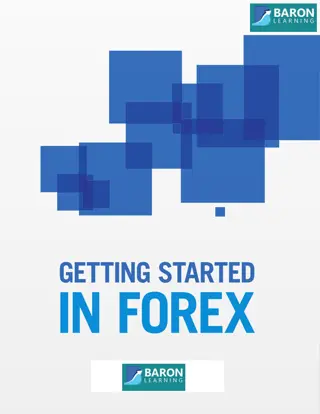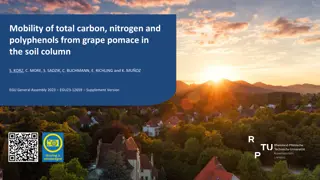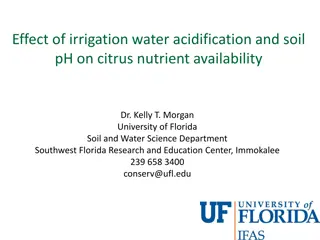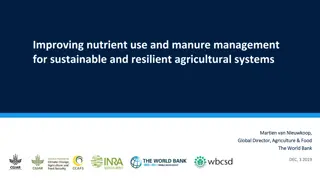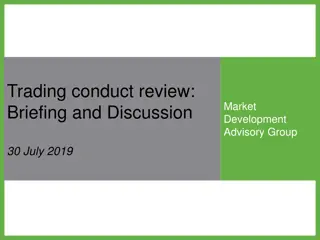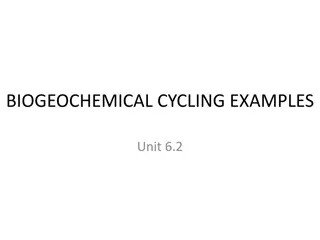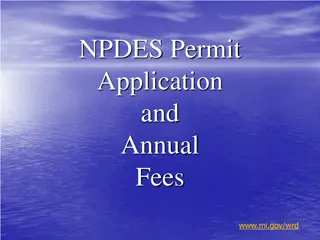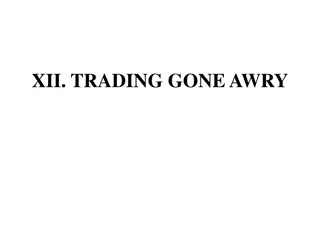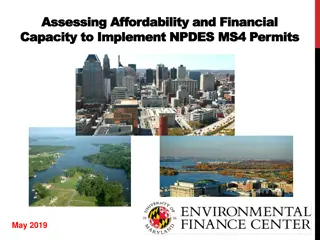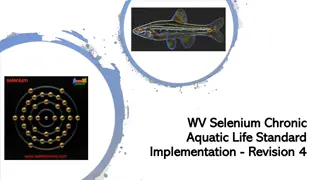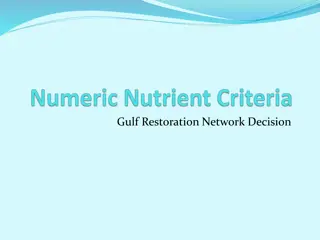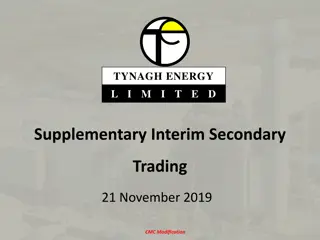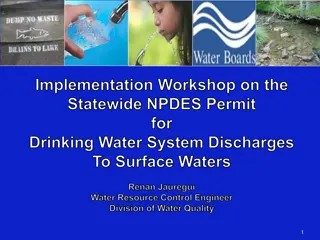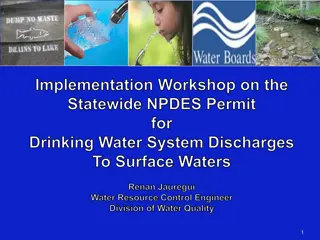Nutrient Trading Program Overview for NPDES Permittees
The Nutrient Trading Program in Maryland establishes a marketplace for water quality credits to meet pollutant load limits, involving sectors like agriculture, stormwater, wastewater, and more. State agencies play critical roles in registering credits, certifying trades, and ensuring compliance. Key terms such as credits, certification, baseline, and verification are defined, along with important ratios like EOT, Reserve, and Uncertainty. The program aims to enhance water quality efforts, protect The Chesapeake Bay, and achieve results more efficiently.
Download Presentation

Please find below an Image/Link to download the presentation.
The content on the website is provided AS IS for your information and personal use only. It may not be sold, licensed, or shared on other websites without obtaining consent from the author.If you encounter any issues during the download, it is possible that the publisher has removed the file from their server.
You are allowed to download the files provided on this website for personal or commercial use, subject to the condition that they are used lawfully. All files are the property of their respective owners.
The content on the website is provided AS IS for your information and personal use only. It may not be sold, licensed, or shared on other websites without obtaining consent from the author.
E N D
Presentation Transcript
Nutrient Trading for NPDES Permittees October 22, 2018 1 to 3 PM Greg Busch Integrated Water Planning Program gregory.busch@maryland.gov MDE trading website mde.maryland.gov/programs/Water/TMDL/TMDLImplementation/Pages/WQ-Trading-2.aspx MDE Trading Administrator e-mail mde.wqtrading@maryland.gov
Outline Trading overview Roles of state agencies Definitions Generating Credits Purchasing Credits Example Trade 2
What is trading? Water Quality Trading Program Establishes a water quality marketplace for meeting and maintaining pollutant load limits Between the agricultural, stormwater, wastewater, and on-site sewage disposal sectors Attract public and private participation Supplement the more traditional governmental approaches for improving water quality Goals Enhance Maryland s effort to protect and restore The Chesapeake Bay and its tributaries Non-tidal waters Achieve results faster and at a lower cost Accelerating efforts to restore and improve water quality 3
State agency roles in the trading program MDA Registration of agricultural credits MDE Registration of: Wastewater credits Septic credits Stormwater credits (and alternative practices) Oyster aquaculture credits Certification of trades to meet MS4 requirements 4
Terms Credit: A unit of load reduction equal to one pound (delivered) of nitrogen, phosphorus or sediment Credit Certification: The process where credits are quantified by the department Baseline: The practices or actions or pollution reductions that must be achieved before a credit seller can generate credit Registration: The placement of credit on the registry after verification and certification Registry: The publicly accessible ledger of credits and trades Verification: the process through which credits are authenticated, either through annual reports or inspections by qualified parties 5
Terms EOT Ratio: A numeric adjustment to compensate for processes through which pollutants are reduced through natural processes before reaching the bay Reserve Ratio: A 5% reduction applied to registered credits to create a credit reserve Uncertainty Ratio: A numeric adjustment to account for inaccuracies in measuring pollutant reductions 1:1 typically 2:1 for trades from NPS to wastewater PS 6
How credits are created and traded 1. 2. 3. 4. 5. 6. A BMP is installed to reduce nitrogen, phosphorus or sediment The BMP owner or other responsible party submits a certification form and verification documentation to MDE or MDA The credit is certified and posted to the registry The credit generator reaches an agreement with a credit purchaser, and a credit acquisition form is submitted to MDE The trade is registered and the transfer of credit is posted in the registry The credit purchaser applies the credit toward meeting a permit requirement Credit Generation Credit Acquisition 7
Generating Non-Agricultural Credits MDE trading website Credit generation for: a. Wastewater b. Septic systems c. Stormwater & alternative urban practices d. Oyster aquaculture Currently based on Phase 5 Model Update with Phase 6 numbers in 2019 Webpage: mde.maryland.gov/programs/Water/TMDL/TMDLImplementation/Pages/WQ-Trading-2.aspx e-mail: mde.wqtrading@maryland.gov 8
EOT Factor Map Determining credit geography Use lat-long to find: Watershed Segmentshed Land-river segment 8-Digit watershed EOT Factors Currently based on Phase 5 Model arcg.is/TiDym 9
Wastewater Performance-Based Credit Generation 1. Modify discharge permit to allow trading (if necessary) Establishes a Benchmark Load under which a permittee can generate credits Establishes a formula for calculating and reporting performance-based credit 2. Complete credit estimation spreadsheet Credit based on performance over one calendar year Form can be completed in January of subsequent year 3. Submit credit certification form To MDE Trading Administrator MDE certifies credit and places credit on registry 10
Wastewater Credit Generation Performance-Based Credits Calculating credits Credit = 8.34 Actual flow [MGD] (baseline actual) concentration [mg/L] Baseline concentration POTWs at ENR: 3.0 mg/L (TN), 0.3 mg/L (TP), 30 mg/L (TSS) Other facilities: assigned within permit Applicable for calendar year that discharge occurred Permanent trades This process does not apply to wastewater point source to wastewater point source (point-to-point) trading 11
Septic Credit Generation Credit for BAT upgrade Accounting for 5% reserve Critical Area: 8.8 lbs/yr EOS 1,000 of non-tidal water: 5.5 lbs/yr EOS All other: 3.3 lbs/yr EOS Connections to WWTP Through WWTP permit Through MS4 accounting arcg.is/yuCnv 12
Stormwater Credit Generation Crediting to follow current MS4 Accounting Guidance Runoff Reduction practices Stormwater Treatment practices Stream Restoration Shoreline Management Forest Planting Impervious surface removal Baseline MS4s: meet permit requirement Non-MS4: current conditions Verification State or county inspector Professional Engineer Department approved verifier Maintenance A maintenance plan must be in place during lifespan of credit Must be done by seller, but can be transferred to buyer Stormwater practices are eligible for funding through Bay Restoration Fund Clean Water Commerce Act Alternative to trading mde.state.md.us/programs/water/StormwaterManagementProgram/Documents/NPDES%20MS4%20Guidance%20August%2018%202014.pdf 13
Oyster Aquaculture Credit Generation Based on Chesapeake Bay Program Expert Panel Report on Oyster Tissue Reductions 14 chesapeakebay.net/documents/Oyster_BMP_1st_Report_Final_Approved_2016-12-19.pdf
Agricultural Credits Nutrient Trading Tool Credit calculator for agricultural BMPs e-mail: nutrade.mda@maryland.gov website: mdnutrienttrading.com website: cbntt.org 15
Registry Publically-accessible ledger of credits and trades Initially Credits generated from wastewater, stormwater and septic practices will be posted on MDE s Water Quality Trading website in a basic ledger Later Registry will be migrated to the Chesapeake Bay Nutrient Trading Tool Each credit will receive a unique ID Indicating the year in which it was created 16
Purchasing Credits Credit Purchaser reaches agreement with Credit Generator Form submitted to MDE Trading Administrator Once approved, transfer of credits will be posted to registry Webpage: mde.maryland.gov/programs/Water/TMDL/TMDLImplementation/Pages/WQ_Trading_Purchasing_Credits.aspx 17
Using Traded Credit to Meet Stormwater Permit Requirements Phase I MS4 permits Current permits must be modified to allow nutrient trading for meeting restoration requirement Subsequent Phase I MS4 permits to allow traded credit for meeting restoration requirement Phase II MS4 permits Current permits allow traded credit to be applied to restoration requirement General Permit for Industrial Stormwater Permit is being modified to allow nutrient trading for meeting restoration requirement Wastewater Permits Need to apply 2:1 uncertainty ratio if purchasing NPS credits Purchased on Maryland s Registry & Marketplace MDE Trading website to provide instructions Credit must be conform with: Trading geography Trading year Maintenance and verification 18
Trading Geographies for MS4s Chesapeake Bay 1 Tidal Fresh Gunpowder River Oligohaline Patapsco River Mesohaline Chesapeake Bay 2 Oligohaline Middle River Oligohaline Back River Oligohaline Chesapeake Bay 3 Mesohaline 19 maryland.maps.arcgis.com/home/webmap/viewer.html?webmap=fdb18dc827654f799d26496f1475055d&extent=-79.9643,37.2887,-75.037,40.1804
Trading Geographies for MS4s CB1TF GUNOH PATMH BACOH CB2OH MIDOH CB3MH 20 maryland.maps.arcgis.com/home/webmap/viewer.html?webmap=fdb18dc827654f799d26496f1475055d&extent=-79.9643,37.2887,-75.037,40.1804
Example Trade A (slide 1) 1. Baltimore County needs 5,000 nitrogen credits to meet its 2018 MS4 permit requirements Example City WWTP 2. They contact Example City WWTP, an ENR plant in Harford County in the CB1TF watershed. Baltimore County MS4 3. Example City WWTP has been discharging nitrogen at 2.6 mg/L below its 3.0 mg/L benchmark load. 4. Example City WWTP is on track to discharge 10,000 pounds below its benchmark load. With an EOT Ratio of 0.57 and a retirement ratio of 5%, it is on track to generate 5,415 pounds of credit for 2018 6. Example City WWTP requests and is granted a permit modification to allow credit generation 7. Baltimore County MS4 requests and is granted a permit modification to allow trading to meet its restoration requirement. 5. Baltimore County MS4 contacts its permit writer to ensure that this credit will be valid for meeting its restoration requirement 21
Example Trade A (slide 2) Example City WWTP 8. In January 2019, Example City WWTP collects its discharge data for 2019 and determines that it can generate 6,000 credits 5,000 Nitrogen Credits Baltimore County MS4 9. Example City WWTP submits formwork to MDE Trading Administrator to certify 6,000 nitrogen credits 10. MDE Trading Administrator certifies the credits. 11. Baltimore county MS4 reaches an agreement with Example City WWTP to trade 5,000 credits 13. Baltimore County will continue purchasing 5,000 nitrogen credits in subsequent years until it has replaced them with structural practices 12. Baltimore County MS4 and Example City WWTP formally complete the trade by submitting a purchase form to MDE Trading Administrator 13. Baltimore County MS4 includes the 5,000 credits in its 2019 MS4 Annual Report 22
Generic timeline for POTW to MS4 trades January 2020: Final discharge monitoring report submitted Prior to or during 2019: WWTP requests permit modification to permit credit generation January/February, 2020: Credit verification form submitted to MDE. Credit posted to registry WWTP operates below benchmark concentration, generates credits 2019 2020 April 2020: Credit is included in Annual Report submission to MDE February/March 2020: Credit acquisition form submitted to MDE. Trade is posted to registry February/March 2020: MS4 establishes agreement with WWTP to purchase credit 23
Contact Information MDE Trading Webpage: mde.maryland.gov/programs/Water/TMDL/TMDLImplementation/Pages/WQ-Trading-2.aspx MDE Trading Administrator: mde.wqtrading@maryland.gov MDA Trading Administrator: nutrade.mda@maryland.gov 24
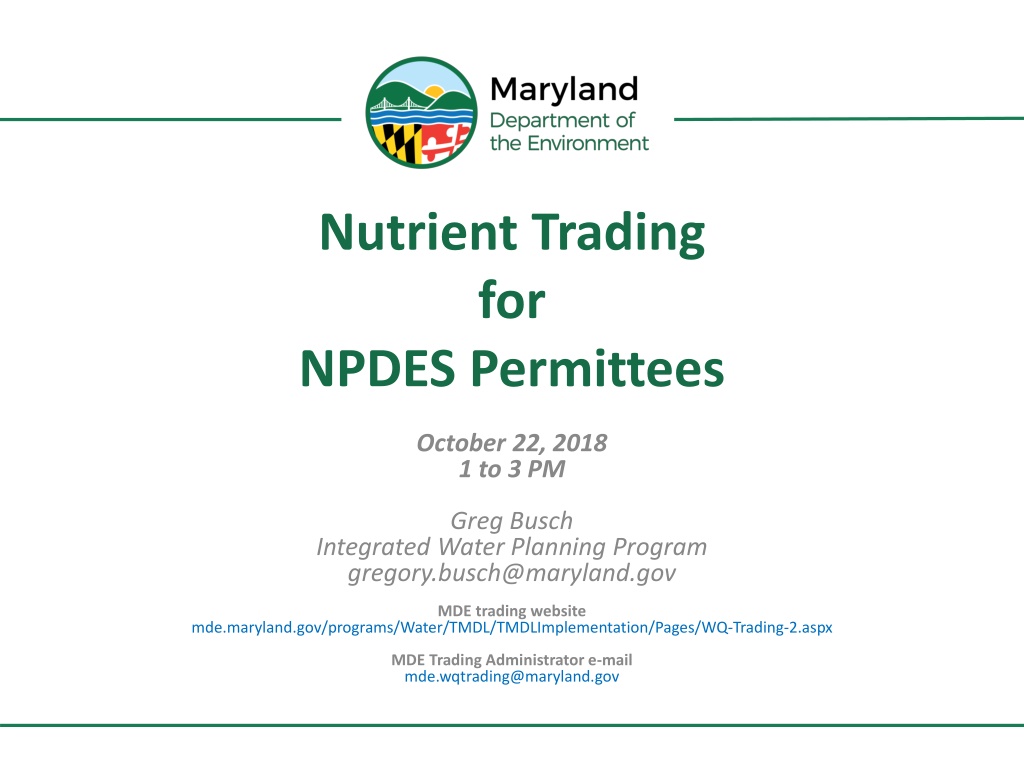
 undefined
undefined







![Guardians of Collection Enhancing Your Trading Card Experience with the Explorer Sleeve Bundle [4-pack]](/thumb/3698/guardians-of-collection-enhancing-your-trading-card-experience-with-the-explorer-sleeve-bundle-4-pack.jpg)


